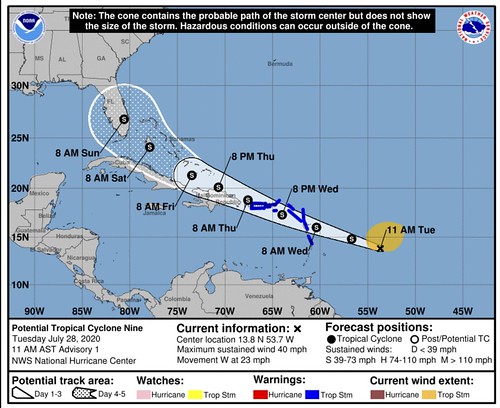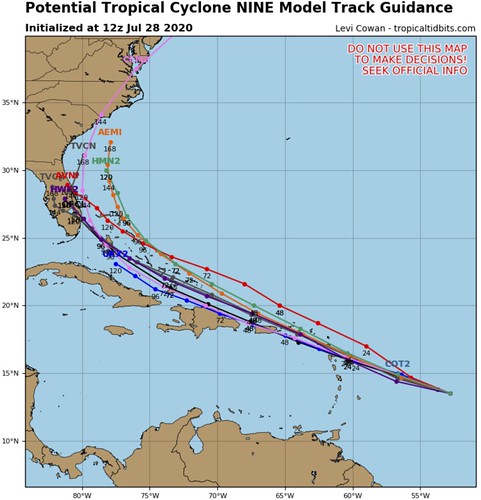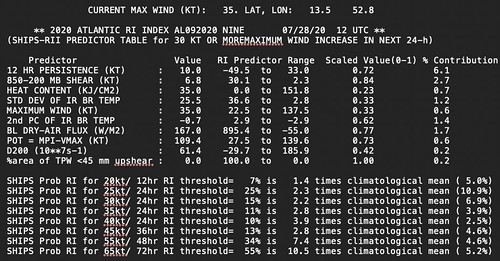The National Hurricane Center has now designated “Invest 92L” as “Potential Tropical Cyclone Nine.” The change in name will only be temporary. The NHC is trying to issue advisories for some of the islands as soon as possible, even though this isn’t a tropical depression or tropical storm yet.
Model Data
Model data suggests PTC9 will be soon. And when it is a tropical storm, it will be named Isaias.
Most models have this as a tropical storm by later today or tonight. And the models also follow the forecast cone – to a point.
Most models start to curve PTC9/Isaias to the north near the Bahamas.
The reason the NHC has the Forecast Cone covering a section of the Gulf is due to some of the Ensemble Models suggesting a stronger ridge of high pressure in the Atlantic. That would nudge PTC9/Isaias into the Gulf.
There is some room for Rapid Intensification within the modeling, too.
The SHIPS model shows that the chance of RI is nearly 10-times the climatological mean. But PTC9/Isaias would have to battle the dry air that is currently around it to do so. And the last storm that was shrouded in the same dry air, Gonzalo, didn’t fare very well with that task.
From the NHC
Potential Tropical Cyclone Nine Discussion Number 1
NWS National Hurricane Center Miami FL AL092020
1100 AM AST Tue Jul 28 2020
Shower and thunderstorm activity has increased overnight and this morning in association with a broad area of low pressure located several hundred miles east of the Lesser Antilles. Recent visible satellite imagery and ASCAT data show that the system’s circulation is quite elongated and lacks a well-defined center. Observations from NOAA buoy 41040 and ASCAT suggest that the system is already producing winds of 30-35 kt, and the systems’s initial intensity has been set to 35 kt. Dry air located just to the north of the system has been hindering development over the past couple of days, but environmental conditions are expected to be more conducive for development over the next couple of days.
Therefore, the system is likely to become a tropical storm before it reaches the Leeward Islands and advisories are being initiated in order to issue Tropical Storm Warnings for a portion of the Leeward Islands, the U.S. and British Virgin Islands, and Puerto Rico. A U.S. Air Force Reserve reconnaissance aircraft is scheduled to investigate the system early this afternoon, and should provide additional information on the intensity and structure of the low pressure area.
It cannot be stressed enough that since the system is still in the formative stage, greater than average uncertainty exists regarding both the short-term and longer-term track and intensity forecasts. A subtropical ridge that extends westward from the central Atlantic is expected to be the dominant steering mechanism over the next several days, and the flow around this ridge should steer the low pressure area generally west-northwestward. However, the details in the track forecast could change depending on exactly where within elongated circulation the center forms.
Regardless of the exact track, the system is expected to bring locally heavy rainfall to much of the Lesser Antilles, and tropical-storm-force winds to portions of the Leeward Islands, the Virgin Islands, and Puerto Rico within the next 24-48 hours. After that time, a general west-northwestward heading should continue but as mentioned before, uncertainty exists as to how close the system tracks to Hispaniola, Cuba, the Bahamas, and Florida. The NHC track forecast is in best agreement with the HFIP corrected consensus model.
It should be noted that a stronger cyclone is likely to favor a more northern track, while a weaker system is likely to remain more equatorward. Users should remember that the long-term average NHC track forecast errors at days 4 and 5 are 140 and 175 n mi, respectively.
Given the current structure of the system, only gradual strengthening is predicted during the next day or two, however the system is expected to become a tropical storm when it is near the Leeward Islands on Wednesday. After 48 hours, possible land interaction with the Greater Antilles, and increasing south to
southwesterly shear from an upper-level trough could temper further strengthening.
The global models generally weaken the system due to these negative factors and the NHC forecast calls for little change in strength at the longer range. Interests in Hispaniola, the Bahamas, Cuba, and Florida should continue to monitor forecasts as changes to both track and intensity are likely.
Key Messages:
1. Potential Tropical Cyclone Nine will produce heavy rains and potentially life-threatening flash flooding and mudslides across the northern Leeward Islands, the Virgin Islands and Puerto Rico.
2. Tropical storm conditions are likely across portions of the Leeward Islands, the Virgin Islands, and Puerto Rico Wednesday through Thursday, and Tropical Storm Warnings are in effect. Do not focus on the details of the track forecast, as rainfall and wind hazards will extend far from the center of the system.
3. The details of the long-range track and intensity forecasts are more uncertain than usual since the system does not have a well-defined center and could move over portions of the Greater Antilles later this week. However, this system could bring some rainfall and wind impacts to portions of Hispaniola, Cuba, the Bahamas, and Florida by the end of the week. Interests there should monitor its progress and updates to the forecast over the next few days.
FORECAST POSITIONS AND MAX WINDS
INIT 28/1500Z 13.8N 53.7W 35 KT 40 MPH…POTENTIAL TROP CYCLONE
12H 29/0000Z 14.8N 56.7W 35 KT 40 MPH…POTENTIAL TROP CYCLONE
24H 29/1200Z 16.0N 60.4W 40 KT 45 MPH…TROPICAL STORM
36H 30/0000Z 17.3N 64.0W 45 KT 50 MPH
48H 30/1200Z 18.8N 67.6W 50 KT 60 MPH
60H 31/0000Z 20.1N 70.7W 50 KT 60 MPH
72H 31/1200Z 21.3N 73.5W 50 KT 60 MPH
96H 01/1200Z 24.1N 77.9W 50 KT 60 MPH
120H 02/1200Z 26.8N 80.6W 45 KT 50 MPH…INLAND





